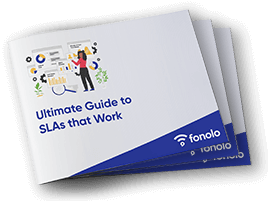If you’re in the contact center industry, 80/20 service levels are likely nothing new. You may have used 80/20 service levels in your operations! You may have wondered where those SLAs came from and if they are right for your business. Those are good questions!
Contact center managers know that SLAs are essential for defining and measuring success for their businesses. These agreements are the bedrock of contact center operations, dictating resource allocation and defining success metrics. Contact centers fixate on getting them right, and it’s no wonder.
Is 80/20 Right for My Contact Center?
To truly understand what SLAs will work for your organization, it’s helpful to have a definition of 80/20. This service level means that 80% of calls should be answered in 20 seconds or less. It’s become a benchmark in the contact center industry, though its origins are not at all scientific nor grounded in research. That may come as a bit of a shock to those who’ve been adhering to them, assuming they were delivering the best results.
There are several reasons why 80/20 might not be the perfect fit for every contact center. For example, many callers will tolerate a wait time that is longer than 20 seconds. A rigid timeframe for all customers doesn’t make sense – especially without data to back it up.
New Considerations: Adapting SLAs to Modern Realities
Advancements in AI and automation should also find you questioning one-size-fits-all service level agreements. Why? For starters, the advent of chatbots and improved self-service means agents are often dealing with more complex problems.
Your agents will handle many calls that have been escalated from automated self-service channels. This means customers have already tried to get a quick answer and failed. This is good call management and call routing – so far, so good – but those customers are going to take more time than things like account balance inquiries and PIN resets.
An 80/20 service level might rush agents through these more in-depth problems, and end up lowering your quality of service, and your CSAT ratings. No one wants that. 80/20 also doesn’t speak to the newer customer service channels on offer today including online chat, SMS, and social media.
LEARN MORE:
Our new tipsheet shares a more detailed look at the variables that impact SLAs, including a discussion of how AI technology is impacting SLA agreements.
How to Create Better Service Levels
To create better SLAs, you have to start with a keen awareness of your business. Knowing your bandwidth and your team’s responsiveness during regular periods – and during crisis and call spikes – will help you set realistic expectations for your clients.
Making promises you can’t keep might work in the short term, but it doesn’t age well. Setting attainable goals will help you earn, and keep, your client’s trust.
In addition to understanding your client’s needs and capacities, you should also consider how valuable the client is to your business. With this information in hand, you can establish a sensible SLA that works for both parties.
Finally, you’ll need to have a solid understanding of your own business priorities. If you’re keen on ensuring low call abandonment rates, then you should construct your service levels to help attain that as a goal. If delivering high CSAT rates is the most important thing, structure your SLAs accordingly.
Call-Backs: A Game-Changer for SLAs
Whatever SLAs you set for your contact center, you should include call-backs in your strategy. Call-backs can even out call volume spikes by deferring calls to quieter times, which prevents agent overwhelm and helps you hit your SLAs. You can use them on any channel – including SMS, social media, and email. And Scheduled Call-Backs let customers choose a call-back at a time they prefer, up to 15 days down the road.
In the ever-changing contact center world, embracing flexibility and modern solutions is key to crafting SLAs that delight your customers and industry standards but exceed customer expectations. So, go ahead, redefine your service levels, and elevate your contact center operations to new heights! And don’t forget your call-backs!


